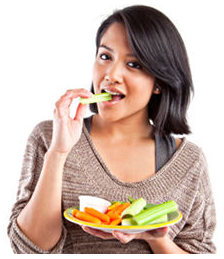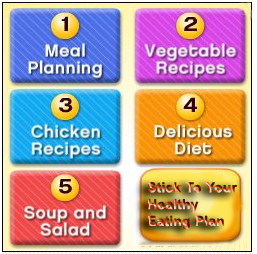Category Archives: Healthy Life
How To Teach Teenagers Healthy Eating HabitsPosted on: July 9, 2018
Let Your Kids Appreciate The Tenets Of Healthy Eating What exactly is “healthy eating”? In conventional terms, healthy eating refers to eating the food from all the food groups. This includes consuming balanced servings of fruits, grains, vegetables, dairy proteins, healthy fats and fibers each day. Healthy eating is the art of balancing nutrient-rich food items with moderate mounts of other food types, like sweets or typical fast-food fare. Healthy eating also refers to eating when you’re hungry and stopping when you are already full Teach Your Teenager To Plan His Or Her Meals Healthy eating means that you aim for eating three regular meals, from breakfast, lunch to dinner. Eating three meals a day, with the usual snacks in between, is actually one of the best ways for maintaining your body’s energy and healthy weight levels. Because most teenagers often skip breakfast, they are more likely to over-eat later in the day, and are more prone to becoming overweight. — Read More –> | |
How To Stick To Your Healthy Eating PlanPosted on: July 2, 2018
Write Your Plan In Paper Start by writing your healthy eating plan on a piece of paper. However, writing it down on paper is so different from having lots of tasty but fattening food in front of you. To formalize your eating plan, grab a meal planning guide from your dietitian, or get a free meal planning guide from health and wellness sites online. A Healthy Eating Plan Isn’t Hard, Provided You Don’t Fall Into A Trap — Read More –> The Perks Of A High-Fiber DietPosted on: June 23, 2018
Fiber Fights Diseases, And Can Help Stop Overeating A diet that’s rich in fiber can help prevent a number of diseases, from constipation to colon cancer. Eating a high-fiber diet actually helps the body reduce or eradicate bad cholesterol, by binding fat and cholesterol in the digestive tract. Natural fiber can also help stop overeating. High-fiber foods take longer to chew and digest, making the person feel satisfied and full longer. Processed Foods Don’t Have Adequate Fiber Content These days, grocery shelves are often filled with lots of processed meats, snacks and other food items. They also contain large amounts of artificial sweeteners, flavorings and preservatives. If you love eating processed foods, you may need to increase your fiber intake, because most processed foods lack adequate fiber content. Fruits, Vegetables And Whole Grains Are Great Sources of Fiber Fruits and vegetables are great sources of dietary fiber, which is actually plant matter. Fiber is largely composed of cellulose, which aids the body in digestion. Whole grains are also excellent dietary fiber sources. When cooking fruits and vegetables, you need not worry about cooking the fiber, because it stays there. The fiber found in most fruits and veggies are not just located on the skin or peel, but deep within. What’s The Recommended Fiber Intake? — Read More –> Eating Guide For KidsPosted on: June 9, 2018 Eating can actually be healthy and fun. But with the proliferation of fast foods and other tasty cholesterol-rich snack items, making your child see the beauty of eating healthy and natural food may become a challenge. Since access to unhealthy food choices are easy, and the choices are plenty, what‘s the best way for introducing healthy eating habits to your kids? Here are some effective healthy eating guidelines to consider.
The typical fast food fare can be very tempting for most kids today. The problem is that the usual fast food fare consists of high-salt, high-sugar and high-calorie food items, which kids find so appealing, and are also easier to eat. For parents who are concerned about their children’s eating habits, learn to keep your cool. The reality is that healthy food can actually taste great. However, making your children love eating healthy food may require more effort and extra planning. While carrot sticks or cauliflower stalks may not be as fun as a plate of French Fries, you’ll require a little time and creativity to make these natural food items appealing to your kids. Slowly Introduce Your Kids To A Wide Array of Fruits and Veggies Making your children adopt healthy eating habits need not end up in a shouting match, or a concentration camp forced-eating regimen. Slowly introducing your children to a wide array of fruits and vegetables will help in jump-starting their appreciation of healthy eating. As most fruits are naturally sweet, it should not pose much of a barrier for kids to like. You can even create stories about the fruits and vegetables they consume, to make things more interesting. The most satisfying thing is that, once your kids consume the fruit, you’re assured that they’re getting their fill of vitamins, minerals and fiber. Cook At Home, And Involve Your Kids — Read More –> | Eating Guidelines For DiabeticsPosted on: June 2, 2018
Choose High-Fiber Vegetables Eating fiber-rich vegetables is good for diabetics, since fiber does not raise or affect blood sugar levels. The vegetables should be minimally processed, and ideally should be eaten raw. Among the fiber-rich veggies that are great for diabetics include cauliflower, celery, cucumber, Brussels sprouts, broccoli, artichokes, cabbage, eggplant, peppers, greens and spinach. Suggested Fruit Variants For Diabetics — Read More –> Five Food Items That Help Lower Bad CholesterolPosted on: May 24, 2018
Kiwi Fruit And Avocado Avocados are delicious and creamy, and they are also good at reducing LDL, or bad cholesterol, as well as regulate blood pressure. Avocados are also rich in plant sterols, soluble fiber, mono-unsaturated fats and minerals. The kiwi fruit is also a low-key but hard working fruit that’s good for the heart. Kiwi has a high potassium content, which helps in regulating blood pressure. . Leafy Greens Are Heart-Healthy Items Leafy greens are good at enhancing your body’s immune system. They’re also good at keeping your heart in good shape. Leafy greens like kale, Swiss chard, spinach, lettuce, broccoli, cauliflower, collard greens, mustard greens other dark green veggies are good sources of calcium, vitamins and other antioxidants. They help reduce plaque build-up in the arteries, and also aid in reducing blood pressure levels. These greens are also good sources of Omega-3 fatty acids. Add fresh greens to your sandwich, taco or pizza, or sprinkle them in your soup and salads. Citrus Fruits — Read More –> Eating Guidelines For Pregnant WomenPosted on: May 17, 2018 Pregnancy is an exciting, but also sensitive time for women. During this period, women Watch Your Serving Size According to nutrition experts pregnant women need an estimated three hundred extra calories each day during this crucial period. However, the extra amount of calories they require will depend on their weight before they got pregnant. Pregnant women also have to follow the appropriate serving recommendations, by talking to their health care provider about having the appropriate eating plan. Pregnant women also need to take close tabs on their serving portions, because they may be eating more than what they think. Daily Food Serving Guidelines To Follow Women should be careful of what they eat, and how they eat during pregnancy. They need to remember that fatty foods like chips, cookies, doughnuts and sweets like sodas and candy do not give their baby the right amount of nutrition they actually need. Here is some interesting food serving guidelines to consider. – Pregnant women should consume at least six ounces of grains per day. An ounce of grains is equivalent to 1 cup ready-to-eat cereal, 1 small pancake, 1 slice bread and 1 small tortilla. – 2 ½ cup serving of vegetables. A cup of vegetables is equivalent to 1 cup vegetable juice, 1 cup raw or cooked vegetables and 1 medium-baked potato. – 1 ½ cup of fruits. A daily serving of 1 ½ cup of fruits is equivalent to ½ cup of fruit, ¼ cup dried fruit, 16 grapes or ½ cup fresh, frozen or canned fruit. – 3 cups of milk each day. This daily serving is equivalent to 1 cup yogurt, 1 ½ ounces natural cheese, 2 ounces processed cheese and 1 cup milk. – 5 ½ ounces of protein each day. This daily serving is equivalent to ¼ cup cooked dry beans, 1 egg, ½ cup nuts, 1 ounce of poultry, meat or fish, and a tablespoon peanut butter. Apart from considering the daily serving guidelines mentioned above, pregnant women should also take regular doses of folic acid. Folic acid helps prevent serious birth defects and spinal cord defects. Women of child-bearing age need to take at least 40 micrograms of folic acid each day before and during pregnancy. Foods that are rich sources of folic acid include enriched grain products, green leafy vegetables, orange juice, beans and vitamin-fortified breakfast cereals. |

 Puberty and adolescence can be very interesting, and frustrating times for parents and teeners. During this crucial stage, most teenagers are highly active, and require more energy from different food sources. To ensure that your teenage son or daughter is able to cope with the rigors of school work and peer pressure, make sure that they develop a healthy eating habit. Most food experts stress that healthy eating is a way of balancing the amount and the type of food you consume, to keep you energized, strong and properly nourished. Here are a few helpful tips for teaching your teenage sons and daughters to adopt healthy eating habits. .
Puberty and adolescence can be very interesting, and frustrating times for parents and teeners. During this crucial stage, most teenagers are highly active, and require more energy from different food sources. To ensure that your teenage son or daughter is able to cope with the rigors of school work and peer pressure, make sure that they develop a healthy eating habit. Most food experts stress that healthy eating is a way of balancing the amount and the type of food you consume, to keep you energized, strong and properly nourished. Here are a few helpful tips for teaching your teenage sons and daughters to adopt healthy eating habits. .

 Healthy Foods Actually Tastes Good
Healthy Foods Actually Tastes Good A diabetic’s life can be tough on his diet. If a person has diabetes, it’s important that he or she is aware of the connection between carbohydrate consumption and diabetes management. Once carbohydrates are synthesized by the digestive system, they become sugars, and have a direct effect on blood glucose levels. A diabetic’s diet must maintain a delicate balance of essential nutrients and minerals. It’s important for diabetics to know what foods to eat, and which ones to avoid.
A diabetic’s life can be tough on his diet. If a person has diabetes, it’s important that he or she is aware of the connection between carbohydrate consumption and diabetes management. Once carbohydrates are synthesized by the digestive system, they become sugars, and have a direct effect on blood glucose levels. A diabetic’s diet must maintain a delicate balance of essential nutrients and minerals. It’s important for diabetics to know what foods to eat, and which ones to avoid.
 need not only take care of their own health, but the health of their offspring as well. However, pregnant women need not give up eating all the food they love. All they need to do is eat smart, and ensure that their food choices are healthy ones. Here are some great healthy eating tips for pregnant women.
need not only take care of their own health, but the health of their offspring as well. However, pregnant women need not give up eating all the food they love. All they need to do is eat smart, and ensure that their food choices are healthy ones. Here are some great healthy eating tips for pregnant women.